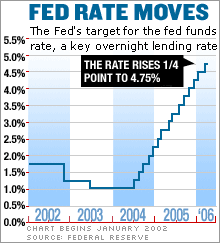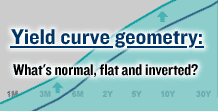|
How to play bonds now
The bond market sell off may not be over just yet. The message for investors: stick to the short end.
NEW YORK (CNNMoney.com) - The Fed is close to ending its interest rate hiking campaign, but Treasury yields may yet have some room to climb. What's a bond investor to do? Central bank policymakers are all but certain to hike the target for the Fed's key short-term interest rate to 5 percent Wednesday, but many market observers are expecting the Fed to pause with its now 22-month old rate-hiking campaign in late June.
With the Fed almost done raising rates, Treasury bonds, whose prices move inversely to yields, are likely to become more attractive to investors. "If you look at history, every time the Fed has stopped raising rates, bonds as an investment have done very well a year and a half later," said Michael Cheah, manager of the SunAmerica GNMA and SunAmerica U.S. Government Securities fixed-income mutual funds. Financial markets generally have interpreted an end to rate hikes as a sign the economy is slowing, and in times of an economic downturn, demand for government bonds -- which are considered safe-haven investments -- tends to rise, along with price. But it can take months before the effects of monetary policy are felt in the market, and several bond analysts said Treasury yields aren't likely to drop off sharply until the end of the year, when an economic slowdown becomes more evident. That leaves many analysts expecting Treasury yields to keep rising for the next few months. "We think bond yields still have some room to go before they peak out in the 5.25 percent range in the summer," Brian Bethune, U.S. economist for Global Insight, said, referring to the yield on the benchmark 10-year Treasury note. Stay short
Bonds face tough competition for investors from stocks, which have been on a tear lately, as well as from high-yield savings and money market accounts, whose rates have soared above 4 percent. But the tide may be starting to turn for bonds. "It's been a tough four months for most bond funds, but with the Fed nearing an end to its cycle, bond funds are starting to look more attractive, particularly short-term bond funds," according to Morningstar analyst Scott Barry. He likes shorter-dated maturities since their yields are nearly as high as intermediate and longer-term bonds but don't carry as much risk. Some of his top picks are Fidelity's Short-Term (Research) and Ultra-Short Bond (Research) funds, as well as Vanguard's Short-Term Bond Index (Research), which have solid track records and low management costs. Andrew Clark, a senior research analyst at mutual fund firm Lipper, also recommends shorter-dated maturities. He said there's risk on the longer end of the yield curve since longer rates are likely to rise, even if the Fed pauses in June. (Confused about yield curves? Click here.) "If you want to be preserving capital, as best as you can with a bond fund these days, you want to be fairly short," he said. Shorter-dated bond prices tend to be less sensitive to interest rate changes than longer-dated bonds. But short rates may start to come back down over time, according to Margo Cook, head of fixed-income management at the investment arm of the Bank of New York. "I think the intermediate part of the curve is attractive," she said, referring to two and five-year notes. Whither bond yields?
But analysts cautioned there's no road map for where rates will go when the Fed takes its foot off the brake, since rates will ultimately be determined by the market and economic forces. Hence, it can be tricky for investors to time the market. To choose an investment strategy, investors need to determine their risk appetite as well as their objective and time frame. "Yields are pretty attractive right now, the question is what is the investor horizon? If they're strictly trading, that is a different objective from looking just for yield pickup," Bethune said. Alfred Mcintosh, a certified financial planner in Los Angeles, said he's staying away from bonds maturing beyond 10 years and will only feel more comfortable moving money to mid-term maturities when the Fed makes a strong statement it's ready to stop raising rates. To smooth out volatility in his clients' portfolios, he recommends spreading investments between corporate, government, high-yield, and international bonds. "Rising interest rates won't affect all of them the same way and that reduces volatility," he said. ------------------ Click here for Investing in Bonds 101.
Having trouble decoding the Fed's message? Click here. |
|



